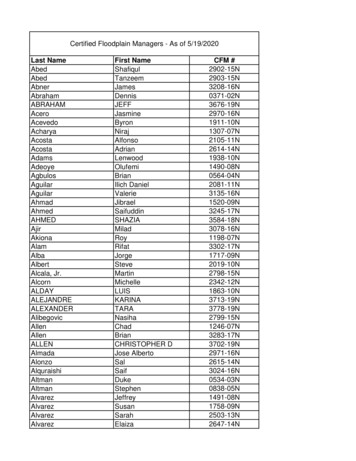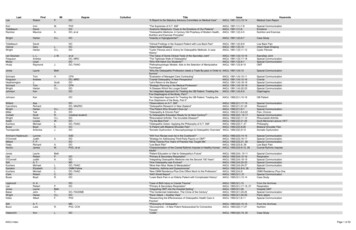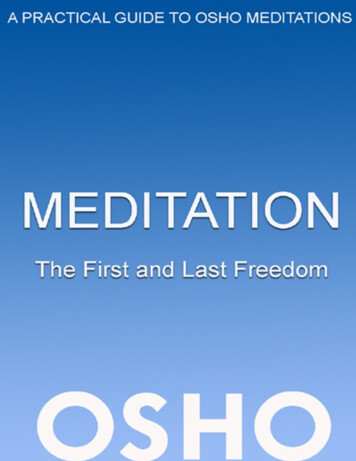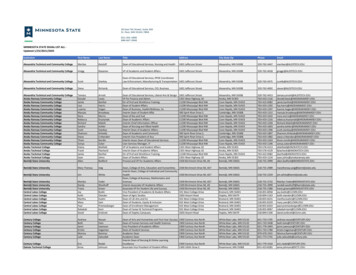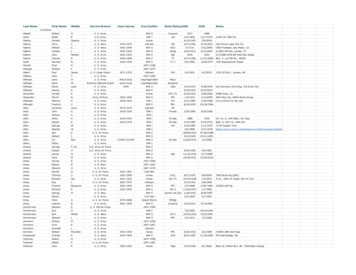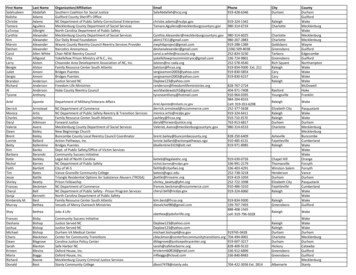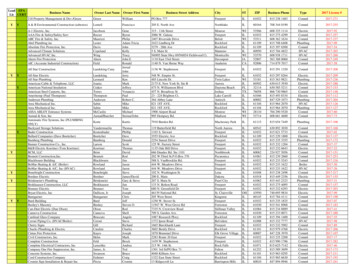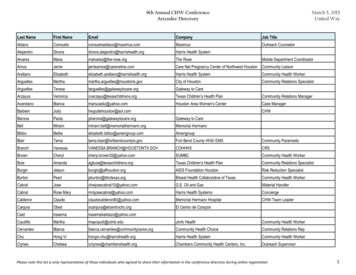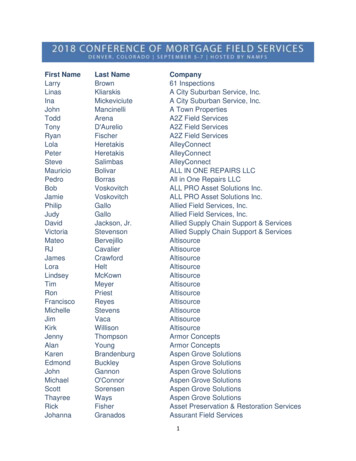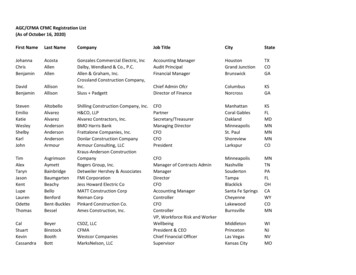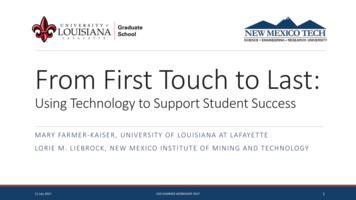
Transcription
From First Touch to Last:Using Technology to Support Student SuccessMA RY FARMER -KAISER, UNIVERSITY OF LOUISIA N A AT L A FAYET TELORIE M. LIEBROCK , NEW MEXICO INSTITUTE OF MIN IN G A N D TECHN OLOGY11 July 2017CGS SUMMER WORKSHOP 20171
AbstractCustomer (aka Constituent) Relationship Management (CRM)systems allow universities to develop customized approaches torecruiting, advising, and communicating with graduate students.They also raise important questions such as: Should a graduate school develop its own system or purchase anexisting product? What are effective strategies for implementation? And how can CRM’s be used to their full potential?This session will provide practical advice based on a variety of models.11 July 2017CGS SUMMER WORKSHOP 20172
What is a CRM and why have one?What is a CRM? It is a tool designed to manage communications, relationships, and reporting processes through the full studentlifecycle—from prospects to students to alumni and donors.As a side note, as you undertake your research you may also learn about ERM “enterprise relationship management” or“extended relationship management” systems, which combine the functions of an ERP and CRM.What are the benefits? A CRM can improve efficiency (automation, tracking, self-service)engage multiple kinds of communicationspromote collaboration and accountabilityenable better data analysis and reporting (and, ultimately, improve your effectiveness)improve the prospect/applicant/student/donor experience by helping to ensure they don’t fall through the cracksother benefits?Do you need one? If you don’t have recruitment, enrollment, and communication strategies, then you don’t need one!11 July 2017CGS SUMMER WORKSHOP 20173
CRM UsesOther department uses:Projects and Research (1),Sales and Marketing (7),Executive DevelopmentPrograms (1), Administration(1), Immigration and OtherStudent Services(1), Communication Services(2), Finance (1), Lectures (1),Exchange Management (1),Event Management (1),Contract Education (1),Newsletter (1), PhD Process(1), Uncertain (3).Customer Relationship Management (CRM) Systems in Higher Education, by Thijs van Vugt & Mykolas Knasys, 201511 July 2017CGS SUMMER WORKSHOP 20174
New Mexico Institute of Mining and TechnologyEstablished in 1889 by act of Territorial LegislatureBSMastersPhDDegrees23179StudentsFull timePart Total2135Center for Graduate Studies responsible for(nearly) all graduate student support fromrecruiting to degree completion checks. CGS haspart time Dean and two full time staff, and parttime student help.Many processes still on paper – 500 paper fileswith manual checks needed.11 July 2017CGS SUMMER WORKSHOP 20175
New Mexico Institute of Mining and TechnologyReasons for wanting a CRM: New NMT president’s goal to grow graduate student population to 1000. Track communications with and progress of students to ensure that questions are answered promptly andcorrectly and to document notifications (not on paper!). This is tied to the need to have simplified processesand automate them (workflow solutions that automatically document approvals and improve reporting). Ultimate goal: improve student success in terms of recruiting, retention, funding, productivity, graduationrate, and research impact.Challenges for implementing a CRM: Our Information Technology and Communication (ITC) department has limited staff and a lot ofresponsibilities; It has been difficult to become high priority with ITC. Historically, NMT has been undergraduate focused with most resources directed to undergraduate programs.This is changing due to a change in leadership – new president and new VPAA. Coordinating with Admissions (undergraduate recruiting) and CGS hampered by reporting to two different vicepresidents; CGS has to lead or graduate students will not be considered.11 July 2017CGS SUMMER WORKSHOP 20176
About theUniversity of Louisianaat LafayetteDoctoral Universities: Higher Research Activity ResearchDoctoral: STEM DominantCarnegie Classification17,519 1,521Total Enrollment Total Graduate Enrollment (Fall 2016)CentralizedAdministrative Model10Number of Graduate School StaffRecruitment Admissions Progression CommencementIssuance of Initial and Transfer I-20sGTA/GRA/GA Budgets and AppointmentsProfessional Development Programming GraduationGrad School Scope of Activities
Graduate Studies at theUniversity of Louisiana at LafayetteDoctoral ProgramsMaster’s ProgramsGrad Certificates103478 PhD 1 EdD DNP63 doctoralgraduates in 2016-17447 master’sgraduates in 2016-2017
University of Louisianaat LafayetteReasons for wanting a CRM:We need to grow graduate enrollment.The University has set a strategic priority of growing graduate enrollment to15% of our total enrollment by 2020.Even without this goal, we could not continue with current operations.All processes were manual in the Graduate School in 2013. Organizationalinefficiencies were everywhere. Communications were not automated. We hadno communications plan. Applicants had no way to check the status of theirapplications without calling or emailing. Our staff size was small and, worse,the Graduate School staff had completely turned over.Broad Initial Challenges:We too are an undergraduate-focused institution.The CRM system was to be shared by Undergraduate Admissions,the Graduate School, and Distance Learning.IT was focused on preparations for a 4-year Banner implementation.We faced discord over the expectation that we’d be moving to theCRM that was purchased with the new “vanilla” ERP.
Group Question: Where are you?Where is your institution in terms of CRM implementation:A. What CRM? We have not even begun looking.B. We are selecting and/or implementing one now.C. We have fully Implemented, but I don’t think we are reaping the fullbenefits.D. We rock. We have CRM deployed across all departments with federatedstudent interactions that help us increase student success, reduce staffworkload, and analyze interaction across the full student lifecycle.11 July 2017CGS SUMMER WORKSHOP 201710
CRM Selection/Implementation Options:FIRST CHOOSE AN IMPLEMENTATION OPTION.Start by reading a number of RFPs from other universities and watch as many demos as you can.Consider implementation options: Purchase a higher education specific CRM.Purchase an off-the-shelf, generic, enterprise-class CRM.Develop CRM in house.Use an open-source CRM.PriceIT Req.Focus *&&& **& ***&&& **&What questions do you need to answer to pick an option. What are your goals?What IT support do you have?What is your budget?What will training look like and what IT support will be required?What are you connecting to the CRM?Who will deploy, maintain, and operate the system? Note focus depends on who is in charge of CRM.11 July 2017CGS SUMMER WORKSHOP 201711
CRM gher-ed-crms.htmlHas listings for Higher Education CRMs Small Business CRMs Other elationship-management-softwareHas listings, with characteristic summary, for Top CRMs Open Source CRMshttp://landing.crmsoftwarereview.org/Has 2017 listing of the “Top 40 CRM Software Report”11 July 2017CGS SUMMER WORKSHOP 201712
www.uofadmissionsmarketing.com201311 July 2017CGS SUMMER WORKSHOP 201713
www.capterra.com11 July 2017CGS SUMMER WORKSHOP 201714
May 2017 freemium and opensource CRMNote these are all enterprise,not academic.www.capterra.com11 July 2017CGS SUMMER WORKSHOP 201715
www.capterra.com11 July 2017CGS SUMMER WORKSHOP 201716
Top 40 CRM Software Comparison byCRM Software crm-software-vendors-v711 July 2017CGS SUMMER WORKSHOP 201717
Higher Education Technology Landscape 2017, by11 July 2017CGS SUMMER WORKSHOP 201718
After you decide on a type, consider:How does the CRM integrate with your existing and future technology?Is the system configurable to your unique business processes?How will your organization deploy a CRM system?How will your organization manage the change?Who will use the CRM (graduate students or will it be used more broadly, i.e., undergraduate, continuingeducation, professional programs, administrative departments, academic departments, etc.) and for what?11 July 2017CGS SUMMER WORKSHOP 201719
Do’s and Don’ts of SelectionDO carefully evaluate your current processes and communications before you begin an RFP.DO contact current users of CRMs with the same Student Information System before purchase.DO watch YouTube videos from other schools in addition to demos on company websites.DO look at the RFPs from other schools, e.g., peer institutions.DO read manuals and spec sheets, watch product demos, and call current clients to confirm.DO be careful how you ask questions, e.g., DON’T ask “Can your CRM integrate with Banner?”, Do ask “Describe how your CRM integrates withbanner and how much institutional effort is needed to do this?”11 July 2017CGS SUMMER WORKSHOP 201720
Do’s and Don’ts of Selection (continued)DO decide what matters for your needs (that matches your resources) and prioritize that in theRFP.DO remember that reporting is a critical function for strategic enrollment management.DO make sure your security requirements are in the RFP before it goes out.DON’T believe everything a vendor says – they sometimes stretch the truth.DO ask to use a demo site/version – don’t trust a vendor that won’t provide one.DON’T weigh cost too high; have a strong negotiator on your team.11 July 2017CGS SUMMER WORKSHOP 201721
University of Louisianaat LafayetteOur CRM Systems:Hobsons Connect interest pagesVIP portaltrackable email campaignsevent managementWe were brought into the shared CRM system (along with DistanceLearning) that Undergrad Admissions had been using for years.Hobsons, of course, has moved away from this CRM to its Radius productand, since our purchase of the Banner ERP, UL is not planning to upgrade.Ellucian Recruit 4.7We are implementing this CRM (and application system) now. Indeed,we’re doing testing this week with the hope to “go-live” next week.
CRM ImplementationCHALLENGES Building and cultivating buy-in(from both inside and outside the Grad School we were truly starting from scratch) Communication Plan11 July 2017CGS SUMMER WORKSHOP 201723
CRM ImplementationCOMMUNICATION PLANAudit your existing communication plan. What are your areas of strength? Where are the criticalgaps?Develop a sustained communication flow that o fits your recruitment cycle(s)o addresses key prospective grad student priorities: (1) quality of program, (2) cost/affordability/funding/ROI,and (3) the pathway forward or careers availableo includes multiple contact strategies (e.g., email, direct mail, live chat, phone, SMS text messages, social media)o starts not at the applicant stage of the funnel but rather with prospects and inquirieso ends not with a decision but continues through to registration and beyond (many use CRMs to update alumnidatabases and to support fundraising efforts)o provides information most relevant to each stage and does not overwhelm with everything at onceThink through consistency, frequency, timing.Understand each communication piece, its intended audience, message and timing, andcall to action.11 July 2017CGS SUMMER WORKSHOP 201724
Communication TemplateUniversity of Maine Graduate SchoolMODEL Communication Plan – Key template/Converting Prospects to Applicants:1. Send thanks for inquiry/send application/program fact sheet(Graduate School).2. Send applicant a note with supplementary forms/program informationsuch as listing of faculty with research interests (program coordinator).3. Follow-up message after several weeks – positioning program(program coordinator).4. Assign graduate students to email prospective students offer to answerquestions.Timeline: June to JanuaryEncouraging Completed Applications:1. Acknowledgment of receipt of application (Graduate School).2. Call student to discuss application and possible funding (programcoordinator).3. Send applicant a timeline for making admissions decisions (programcoordinator).4. Contact from potential faculty advisor(s).5. Email reminder to complete application (Graduate School).6. Acknowledgment of completed application (Graduate School)Timeline: October to JanuaryConverting Acceptances to Enrollments:1. Admission letter/ setting up FirstClass account(Graduate School)2. Congratulations and financial award letter (programcoordinator).3. Call applicant to talk about research project, length offunding (program coordinator or faculty advisor).4. Welcome letter from department chair or collegedean.5. Email from graduate student to talk about student life.6. Invitation to visit campus (program coordinator).7. Invitation to orientation program (Graduate School).8. Call from alumnus to discuss graduateprogram/opportunities.Timeline: January to April
CRM ImplementationCHALLENGES (continued) Building and cultivating buy-in(from both inside and outside the Grad School we were truly starting from scratch) Communication Plan Resources Time and timeline Multi-office implementation and use Communication Data quality Building, testing, and perfecting filters System readiness and testing Training11 July 2017CGS SUMMER WORKSHOP 201726
Do’s and Don’ts of ImplementationDON’T go into implementation without preparation.Know your business processes and your communication plan, think through your filters(intended audience), and have content and images ready to go.DON’T implement in a vacuum.Include current / potential users from the start and do so in more than a token way.DON’T waste time with your consultant.Be prepared with questions, examples, and scenarios.DON’T expect the implementation to be perfect on day one.It’ll take time to identify and fix the “bugs” and to refine.DON’T overthink it.Keep your goals focused, your content tight, and continue to see the CRM as a “living” system.11 July 2017CGS SUMMER WORKSHOP 201727
Do’s and Don’ts of ImplementationDO be realistic about your timeline.DO be ready to compromise.This is especially true if your implementation is dependent upon IT and/or the CRM is intendedfor use by multiple offices.DO communicate.Keep your staff updated. Ownership and inclusion goes a long way toward the successfuladoption of new systems, processes, and procedures.DO develop a naming convention for folders, filters, emails, etc. that everyone working in theCRM uses.DO spend time building your filters and getting them right.DO perform testing before going “live.”You simply cannot test enough.11 July 2017CGS SUMMER WORKSHOP 201728
DiscussionPick your group’s top one or two questions for focus in eachsection — selection, implementation, and effective use — andprovide written notes for your group.As we discuss, we will ask a group or two to discuss theirresponses, but we’ll also compile all of the notes for a summaryto be share with participants following the conference.Group leaders, please email your written notes to jkent@cgs.nche.edu, graduate@nmt.edu, andkaiser@louisiana.edu. We encourage you to answer as many of the questions in your individual emailresponses.11 July 2017CGS SUMMER WORKSHOP 201729
Discussion: Selection Best PracticesWhat type of CRM are you considering and why (in-house development, enterprise, opensource, higher-education specific)?What are your top three requirements for your CRM?What are your top three recommendations for others who are beginning the search for a CRM?What functions do you use or plan to use in the CRM? (recruiting, retention, etc.)If you have a CRM: What do you use?How well does it work for you?What was your top reason to choose it?What are the features that you like/use most?If you could only change one thing, what would it be and how would you change it?What are the upfront, maintenance, and “hidden” costs (e.g., requires SalesForce)?11 July 2017CGS SUMMER WORKSHOP 201730
Discussion: Implementation Best PracticesWho needs to be on your implementation team?Who should lead it?Who needs to be brought into the implementation as you move toward training and “go-live”?How do you balance implementation with day-to-day operations?What’s an ideal initial Graduate School communication plan look like?What are the key consistency, frequency, and timing issues that need to be considered?Who should develop and/or approve the content?If you’ve gone through a CRM implementation, what’s the one thing you wish you would havedone differently?If you’ve implemented a non-higher-education-specific CRM, what are the implementationbenefits/challenges that come with (a) an off-the-shelf enterprise-class CRM, (b) an in-houseCRM, or (c) an open-source CRM?11 July 2017CGS SUMMER WORKSHOP 201731
Discussion: Effective Use Best PracticesHow many times do you communicate at each stage? What are the key touchpoints? When iscommunication most critical? How much is too much and/or too little communication?What kinds of communication do you use? What do you use beyond email (e.g., direct-mail, SMStext messages, live-chat, social media, phone)? Which are most effective? How do you track allforms of communications and their effectiveness?How do you engage others – e.g., academic departments and program coordinators, distancelearning, international affairs, financial aid, housing – in your communication flow? What iscommunicated by whom?How often do you audit of your content and/or update your content?What is the most innovative thing you do with your CRM?Are you using your CRM beyond recruitment and admissions? Are you using it for eventsmanagement? to track post-graduation activity? to engage donors?11 July 2017CGS SUMMER WORKSHOP 201732
CRM Discussion RecapPlease don’t forget to email your comments to jkent@cgs.nche.eduand graduate@nmt.edu and kaiser@louisiana.eduso we can integrate responses and make them available.Thank you for your thoughtful input and participation.11 July 2017CGS SUMMER WORKSHOP 201733
References and Resources 2014-2015 State of CRM Use in Higher Education Report ort bw.pdf?sfvrsn 2 Buying a CRM Solution in T-0169130 CRM Buyer s Guide.pdf A Buyer’s Guide to Customer Relations Management Solutions: Industry-Driven Solutions, Value, and Evaluation ers-guide.pdf CRM Buyers Guide: A Comparative Analysis of the Top CRM Vendor Solutionshttp://www.crmsearch.com/crm-report.php CRM Buyer’s Guide for ome/ /?auth co&loc en US&id 395291&part 15 CRM Buyers Guide, Volume II: What’s the Right CRM System for stem.pdf CRM in Higher Education: The Secret Guide, Jens 7/crm-in-higher-education-secret-guide.html “Customer Relations Management: A Vision for Higher Education,” chapter 3 in Web Portals and Higher Education: Technologies to Make IT Personal Customer Relation Management Buyer’s Guide: Innovations in ment-Buyers-Guide-Innovations-in-CRM.html Customer Relationship Management (CRM) Systems in Higher Education: The Guide to Selecting a CRM for Higher Education -systems-in-higher-education/ Industry Solutions Guide: Selecting a CRM Vendor in the Higher Education Market (Competitor Focus)https://www.slideshare.net/ReportLinker
Our CRM Systems: Hobsons Connect interest pages VIP portal trackable email campaigns event management We were brought into the shared CRM system (along with Distance Learning) that Undergrad Admissions had been using for years. Hobsons, of course, has moved
![Last or Business First [Maiden] Page Title Notes](/img/1/saukcity125thjubilee-20historical-20album-index.jpg)
